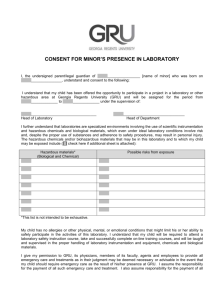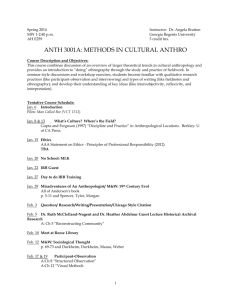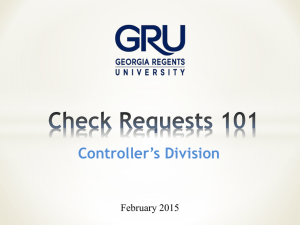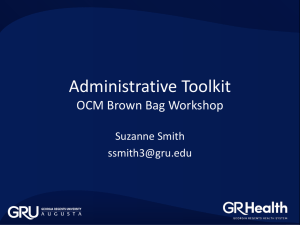Accounting 101 Module II Budget Training
advertisement
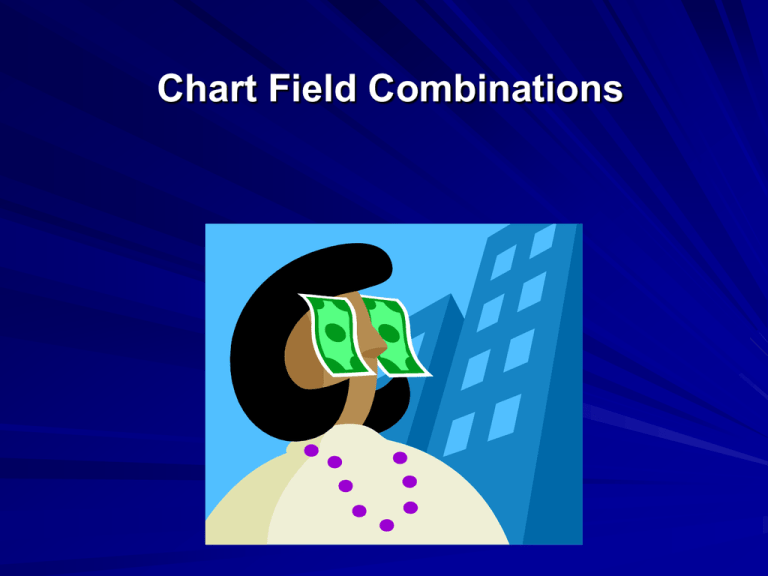
Chart Field Combinations Purpose This session is designed to provide an overview of Fund Accounting and its application at Georgia Regents University using Chart Field Combinations. Objectives Learn the basics of Fund Accounting Learn about GRU Funds Learn about Chart Field Combinations Learn the basics of accounting entries Agenda Overview of Fund Accounting GRU Funds The concept of Chart Field Combinations and their purpose Basic accounting entries using funds and chart field combinations Basics of Fund Accounting Governmental focus Self-balancing set of accounts per fund The basic accounting equation: Assets = Liabilities + Owner’s Equity +(Revenue-Expenses) Fund Accounting and the Board of Regents Example: BOR Financial Statements GRU Financial Statements Fund 10000 Fund 12000 UGA Financial Statements Fund 10000 Fund 20000 GRU Funds Unlimited number may be used; however, limited by practicality Other Chart Field Identifiers are used for reporting/further definition What Are Chart Fields? The Chart Field Combination (CFC) is composed of: – – – – – – – Account Code Fund Department Program Class Budget Period Project/grant ID (if necessary) The term “Chart Field Combination” (CFC) is a standard PeopleSoft term. What does the CFC tell us? The Chart Field Combination (CFC) are numerical characters that tell us: – What the funds were used for – Where the funds came from – Who (i.e. what school) the funds belong to Account Codes The “What” Descriptor of the nature of the revenue, expense, asset, liability or net asset (fund balance) accounts Account Codes 1XXXX – Assets 2XXXX – Liabilities 3XXXX – Net Assets, Reserves 4XXXX – Revenues 5XXXX thru 8XXXX – Expenses 9XXXX – Allocation Transfers Fund Code The “Where” part I The source or nature of the item Fund Groups Unrestricted – Operating Restricted Purpose Loan Funds Endowment Plant Agency (funds held for others) (1XXXX) (2XXXX) (3XXXX) (4XXXX) (5XXXX) (6XXXX) Department Code The “Who” First 2 digits represent a School or admin unit The next four digits are dept defined – generally a dept or program with the first 2 digits If the first of last digit is an “A”, it is an agency code Program Code The “How” the funds are to be used Defined by the BOR Based on the NACUBO (National Association of College and University Business Officers) “functional” area Program Code Overview Education & General - 1XXXX Auxiliary Enterprises - 2XXXX Other - 3XXXX Program Code Detail Education and General Instruction Research Public service Academic support Student services Institutional Support Plant Operations Scholarships and Fellowships 11XXX 12XXX 13XXX 14XXX 15XXX 16XXX 17XXX 18XXX Program Code Detail Auxiliary Enterprises Housing Food services Stores Health services Transportation and Parking Auxiliary Plant Other Organizations 21XXX 22XXX 23XXX 24XXX 25XXX 26XXX 27XXX Program Code Detail Other Patient care 32XXX Class Code The “Where” part II – Generally correlates with the Fund – Gives a more detailed “Where” than the Fund Detailed Source/Use of funds Used for both revenues and expenditures Unique to the State of Georgia Class Code Examples: 11000 General Operations 19000 Dept Sales 41100 Dept Sales 61000 Sponsored Federal 61031 Federal Work Study 64060 Clinical Trials Project/Grant ID Identifies a specific Sponsored agreement or a project Up to 15 digits in length Generally, if code starts with Alpha, it is a grant If it starts with numbers, generally it is a project Project/Grant ID Examples: MERCK00001 – A Merck Pharmaceuticals Clinical Trial NHLBI0001 – An (NIH) National Heart, Lung and Blood Institute Grant VAMC0001 – A Veterans Affairs Medical Center IPA for Dr. Smith 0044008 – 28th Annual Opthal Symposium Budget Period The Year in which revenues, expenses, encumbrances originated Basics of Accounting Entries Double entry – Use two columns and amounts are not distinguished by + or – Ex. Cost Transfer Form Debits and Credits – Whether a debit or credit increases or decreases a balance depends on the type of account More Debits and Credits Example – Dividend, Expense, Assets, and Losses (DEAL): Debits increase while credits decrease the balance – Gains, Income, Revenues, Liabilities, and Stockholder’s Equity (GIRLS): Debits decrease while credits increase the balance. Questions/Answers References Websites – GRU Controllers Office http://www.georgiahealth.edu/finance/controll er/ – USG BOR Policy Manual http://www.usg.edu/business_procedures_ma nual/ Conclusion This concludes Chart Field Combinations If you have any questions, you may contact – – – – – Laura Craft – lcraft@gru.edu, 706-721-6235 Karen Castleberry – kcastleberry@gru.edu, 706-721-2135 Barandy Brock – bbrock@gru.edu, 706-721-2903 Andrea Buchanan – abuchanan@gru.edu, 706-721-2136 Julie Wilson – jwilson@gru.edu, 706-721-9179 Thank you


